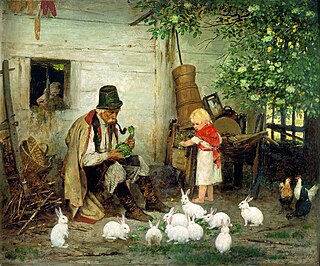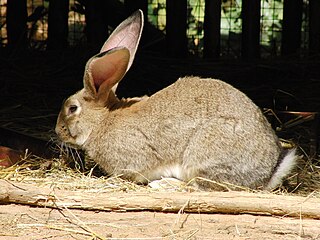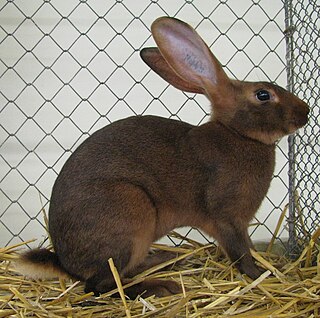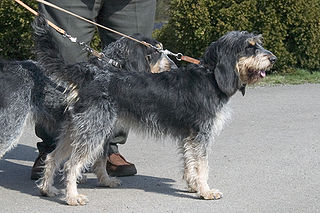Related Research Articles

Cuniculture is the agricultural practice of breeding and raising domestic rabbits as livestock for their meat, fur, or wool. Cuniculture is also employed by rabbit fanciers and hobbyists in the development and betterment of rabbit breeds and the exhibition of those efforts. Scientists practice cuniculture in the use and management of rabbits as model organisms in research. Cuniculture has been practiced all over the world since at least the 5th century.

The Angora rabbit, one of the most ancient groups of domestic rabbit breeds, which is bred for the long fibers of its coat, known as Angora wool. They are gathered by shearing, combing or plucking. Because rabbits do not possess the same allergy-causing qualities as many other animals, their wool is an important alternative. There are at least 11 distinct breeds of Angora rabbit, four of which are currently recognized by the American Rabbit Breeders Association (ARBA): the English Angora, the French Angora, the Giant Angora and the Satin Angora. Other unrecognized breeds include the German Angora, the Finnish Angora, the Chinese Angora, the Japanese Angora, the Korean Angora, the Russian Angora, the St Lucian Angora and the Swiss Angora.

The domestic rabbit is the domesticated form of the European rabbit, a member of the lagomorph order. A male rabbit is known as a buck, a female as a doe, and a young rabbit as a kit. There are hundreds of rabbit breeds, originating from all over the world.

The Holland Lop is a breed of lop-eared rabbit that was recognized by the American Rabbit Breeders Association (ARBA) in 1979. The Holland Lop, with a maximum weight of 1.8 kg (4 lb), is one of the smallest lop-eared breeds.

The Basset Bleu de Gascogne, also known as the Blue Gascony Basset, is a long-backed, short legged breed of dog of the hound type. A French native breed, it is rare outside its homeland. It is recognized internationally by the Fédération Cynologique Internationale, in the UK by The Kennel Club, and by the United Kennel Club in the United States. The "bleu" of its name is a reference to its coat which has a ticked appearance.

The Flemish Giant rabbit is the largest breed of domestic rabbit. They weigh 6.8 kilograms on average, though the largest ones can weigh up to 22 kilograms. Historically they are a utility breed used for their fur and meat. In the modern day, they are no longer commonly raised for meat, due to their slow growth and very large bones, and are raised for exhibition at rabbit shows. They are often kept as pets as they are known for being docile and patient when being handled.

The Picardy Spaniel is a breed of dog developed in France for use as a gundog. It is related to the Blue Picardy Spaniel, and still has many similarities, but the Picardy Spaniel is the older of the two breeds. It is thought to be one of the two oldest continental spaniel breeds and was favoured by the French nobility, remaining popular for hunting after the French Revolution due to its weather resistant coat that enabled it to hunt in a variety of conditions and terrain. However its popularity waned following the influx of English hunting breeds in the early 20th century. Slightly smaller than an English Setter but larger than most of its spaniel cousins, it has no major health issues although as with many breeds with pendulous ears, it can be prone to ear infections.

The American Rabbit is a breed of rabbit, recognized by the American Rabbit Breeders Association (ARBA) in 1917. According to the ARBA Standard of Perfection, American rabbits have a mandolin body shape. It has also been noted for a docile temperament and good mothering abilities. As with all domestic rabbits, the American breed is of the species Oryctolagus cuniculus, the European wild rabbit.
The Beveren is one of the oldest and largest breeds of fur rabbits. It was first bred in Beveren, a small town near Antwerp in Belgium. Their coats can be blue, white, black and lilac, though not all of these varieties are ARBA-recognized. There is a rare variety called the Pointed Beveren, which comes in the same colors but has white tipped hairs. The blue variety is the original.

The Argenté rabbit is one of the oldest breeds of French show rabbits. The British Rabbit Council (BRC) recognises six varieties: Argenté Bleu, Argenté Brun, Argenté Crème, Argenté de Champagne, Argenté Noir, and Argenté St Hubert. The American Rabbit Breeders Association (ARBA) recognises the Champagne d'Argent, the Crème d'Argent and the Argenté Brun. A rare variety, the Argenté Clair, is not currently recognised by either the BRC or ARBA.

The Belgian Hare is a "fancy" breed of domestic rabbit. It has been selectively bred to resemble the wild European hare, but nevertheless, it is a rabbit rather than a true hare. Averaging 6–9 pounds (2.7–4.1 kg), the Belgian Hare is known for its slender and wiry frame and its long and powerful legs. The breed is responsible for launching the domestic rabbit industry, as well as popularizing rabbit shows in the United States.

The Griffon Bleu de Gascogne is a breed of dog of the scenthound type, originating in France, and is a versatile hunting dog, used on small and large game, in packs or individually. The Griffon Bleu de Gascogne has a speckled, rough coat.

The New Zealand is a breed of rabbit, which despite the name, is American in origin. The breed originated in California, possibly from rabbits imported from New Zealand. New Zealand rabbits are available in five colors recognized by the American Rabbit Breeders' Association (ARBA): white, red, black, blue, and broken. Crossbreeding can result in many other variations, such as gold tipped steel and chestnut agouti. They average 10–12 lb (4.5–5.4 kg) with the does being slightly larger than the bucks. New Zealands are bred for meat, pelts, show, and laboratory uses, being the most commonly used breed of rabbit both for testing and meat production. They are also bred as pet rabbits but mostly breed for meat.

The Blanc de Hotot is a medium-sized rabbit breed originally developed in France. It is a compact, thickset white rabbit with spectacle-like black rings around each dark eye. First bred in Hotot-en-Auge, Normandy, France in the early 1900s, the breed spread throughout Europe and into North America by the 1920s. Initially unpopular in the United States, it died out there, and suffered population decline in World War II-era Europe. It began to spread again in the 1960s and 1970s, and was re-imported to the US in 1978. Today it is recognized by the British Rabbit Council and the American Rabbit Breeders Association, but is considered globally endangered, with a listing of "threatened" status by the American Livestock Breeds Conservancy.
The Brown Chestnut of Lorraine is a breed of domestic rabbit that originated in France and is named for the Lorraine region. The breed is currently considered rare. It was developed by Ch. Kauffmann from Garenne and Tan rabbit stock. The ideal weight for this breed is 2–2.4 kilograms (4.4–5.3 lb). This rabbit has chestnut brown fur.

The Fee de Marbourg is a breed of rabbit that originated in Germany where it became known as the Fee de Marbourg, literally "Fairy from Marbourg." The British Rabbit Council recognizes this breed as the Marburger Fee and in the UK it is sometimes referred to as the Marburger.

The Blue Bird is an oil painting created in 1912–1913 by the French artist and theorist Jean Metzinger. L'Oiseau bleu, one of Metzinger's most recognizable and frequently referenced works, was first exhibited in Paris at the Salon des Indépendants in the spring of 1913, several months after the publication of the first Cubist manifesto, Du "Cubisme", written by Jean Metzinger and Albert Gleizes (1912). It was subsequently exhibited at the 1913 Erster Deutscher Herbstsalon in Berlin.
The Blue Imperial rabbit was an English breed of domestic rabbit that is now extinct. It was originally bred by Miss Mabel Illingworth (1879-1955), who was the first woman to create a rabbit breed. It was used to create several modern breeds, including the American rabbit.
References
- 1 2 3 "Bleu de Ham ("Blue of Ham")". Les Amis du Petit Elevage de Villers la Ville ("Friends of Small Livestock of Villers la Ville") (in French). 17 January 2014. Archived from the original on 22 May 2022. Retrieved 17 March 2018.
- 1 2 "Types of Rabbit Breeds". Archived from the original on 2 April 2015.